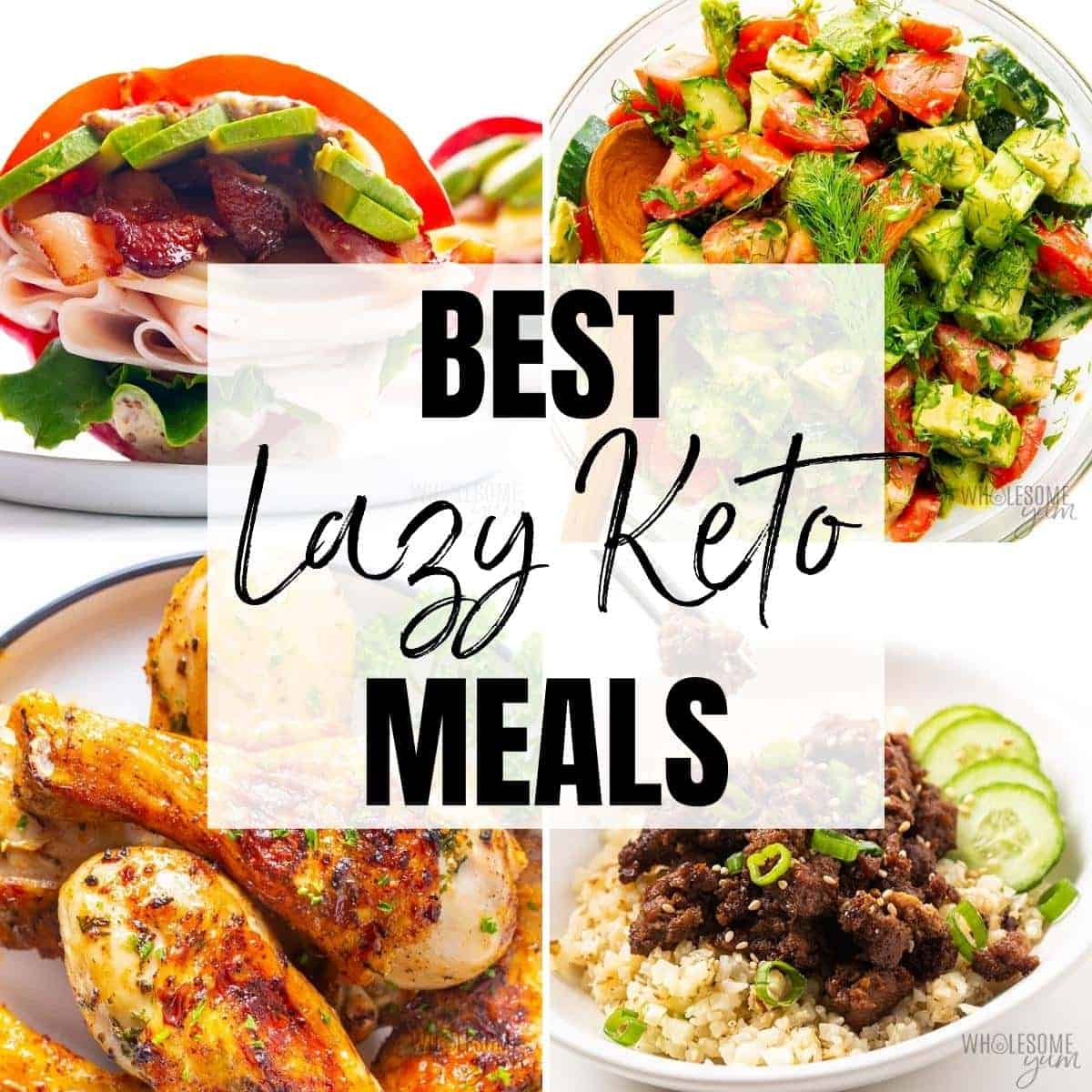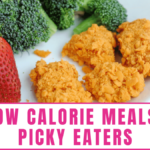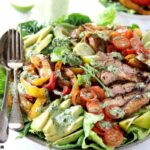Embark on a culinary journey designed for the discerning clean eater seeking delicious, low-carb options. This comprehensive guide unveils a world of vibrant flavors and satisfying meals, carefully crafted to nourish your body and delight your senses. Discover an array of popular low-carb ingredients, their surprising versatility in breakfast, lunch, and dinner recipes, and simple strategies to incorporate them into your daily routine. Prepare to be inspired by quick weeknight dinners, creative meal prep ideas, and even advanced recipes for the adventurous cook. This isn’t just about restriction; it’s about unlocking a world of culinary possibilities.
We’ll explore simple, yet flavorful, low-carb recipes perfect for busy schedules, offering step-by-step instructions and visually appealing presentations. Learn to master the art of low-carb meal prepping, ensuring you always have healthy and satisfying options at your fingertips. We’ll delve into the nutritional benefits of key ingredients, providing a balanced perspective on macronutrients and offering solutions for various dietary needs and preferences. Get ready to elevate your clean eating journey to new heights.
Popular Low-Carb Ingredients
Embarking on a low-carb, clean-eating journey requires understanding the foundational ingredients that support both weight management and overall well-being. These ingredients are not only low in carbohydrates but also rich in essential nutrients, providing sustained energy and satiety. The following explores key ingredients and their versatile applications in delicious and healthy meals.
Popular Low-Carb Ingredients Table
Choosing the right ingredients is crucial for a successful low-carb diet. The following table highlights ten popular low-carb options, detailing their nutritional benefits and culinary uses. Each ingredient offers unique flavors and textures, making it easy to create diverse and satisfying meals.
| Name | Nutritional Benefit | Culinary Use | Example Recipe |
|---|---|---|---|
| Avocado | Rich in healthy fats, fiber, and potassium. | Guacamole, salads, smoothies, toast topping. | Avocado and Shrimp Salad |
| Salmon | Excellent source of omega-3 fatty acids, protein, and vitamin D. | Grilled, baked, pan-fried, used in salads or tacos. | Pan-Seared Salmon with Asparagus |
| Spinach | High in vitamins A, C, and K, and iron. | Salads, smoothies, sautéed dishes, omelets. | Spinach and Feta Omelet |
| Cauliflower | Good source of fiber and vitamin C. Versatile and can replace grains in many dishes. | Rice, mash, pizza crust, roasted. | Cauliflower “Rice” Stir-fry |
| Broccoli | Excellent source of vitamins C and K, fiber, and antioxidants. | Roasted, steamed, added to stir-fries or soups. | Roasted Broccoli with Garlic and Parmesan |
| Eggs | Complete protein source, rich in choline and various vitamins. | Omelets, frittatas, scrambled, poached, boiled. | Three-Egg Omelet with Mushrooms and Cheese |
| Nuts (almonds, walnuts, pecans) | Good source of healthy fats, protein, and fiber. | Snacks, salads, baked goods, added to yogurt or smoothies. | Almond Flour Pancakes |
| Chia Seeds | Rich in omega-3 fatty acids, fiber, and antioxidants. | Added to smoothies, yogurt, puddings, or baked goods. | Chia Seed Pudding with Berries |
| Olive Oil | Healthy monounsaturated fats, beneficial for heart health. | Used for cooking, dressings, and marinades. | Mediterranean Salad with Olive Oil Dressing |
| Coconut Oil | Contains medium-chain triglycerides (MCTs), which are quickly metabolized for energy. | Used for cooking, baking, and adding to coffee. | Coconut Oil Roasted Vegetables |
Creative Low-Carb Breakfast Recipes
Integrating low-carb ingredients into breakfast routines is simpler than you might think. The following ideas showcase quick and flavorful options that will keep you satisfied and energized throughout the morning.
Breakfast recipes using the above ingredients can be easily customized to personal preferences and dietary needs.
1. Avocado Egg Boats: Halve avocados, remove the pit, and fill with a fried egg seasoned with salt, pepper, and a sprinkle of everything bagel seasoning. Imagine the creamy richness of the avocado contrasting beautifully with the firm texture of the egg yolk, all heightened by a delightful blend of spices.
2. Spinach and Feta Omelet with Mushrooms: A classic breakfast with a low-carb twist. The vibrant green spinach provides a fresh counterpoint to the salty feta, while earthy mushrooms add a depth of flavor. Picture the fluffy texture of the omelet, speckled with the bright green spinach and creamy white feta.
3. Salmon and Avocado Toast (using almond flour toast): A sophisticated take on a classic. Flaked salmon, rich in omega-3s, is paired with creamy avocado on a crispy almond flour toast. Envision the delicate, flaky salmon resting atop the smooth avocado, all nestled on a lightly browned, nutty-flavored toast.
4. Chia Seed Pudding with Berries: Prepare the night before for a grab-and-go breakfast. The pudding’s smooth, creamy texture is complemented by the burst of sweetness and antioxidants from fresh berries. Picture a vibrant purple and red swirl within the creamy, almost gelatinous chia seed base.
5. Broccoli and Cheese Frittata: A hearty and satisfying breakfast option. Tender broccoli florets are combined with your favorite cheese for a protein-packed and flavorful start to the day. Imagine a golden-brown frittata, studded with vibrant green broccoli and pockets of melted cheese.
Versatility of Three Key Ingredients
The versatility of certain ingredients allows for endless culinary exploration within a low-carb framework. The following demonstrates the adaptability of avocado, salmon, and cauliflower across various meals.
Avocado:
Lunch: Avocado Chicken Salad: Diced chicken breast, avocado, celery, red onion, and a lemon vinaigrette are combined for a refreshing and healthy lunch. Imagine a vibrant salad with chunks of juicy chicken and creamy avocado, all brightened by a zesty lemon dressing.
Dinner: Avocado Shrimp Ceviche: Fresh shrimp marinated in lime juice, cilantro, and diced avocado makes a light and flavorful dinner. Picture a vibrant mix of bright orange shrimp and creamy avocado, all infused with the bright citrus notes of lime and the freshness of cilantro.
Salmon:
Lunch: Salmon Salad Lettuce Wraps: Flaked salmon, mixed with mayonnaise, celery, and onion, is served in crisp lettuce cups. Picture crisp lettuce cups overflowing with a creamy salmon salad, offering a refreshing and light lunch option.
Dinner: Baked Salmon with Roasted Vegetables: Salmon fillets are baked alongside a medley of roasted vegetables like broccoli, asparagus, and bell peppers. Imagine tender salmon fillets with a slightly crispy skin, nestled alongside vibrant roasted vegetables.
Cauliflower:
Lunch: Cauliflower “Fried Rice”: Cauliflower rice is stir-fried with eggs, vegetables, and soy sauce for a low-carb twist on a classic. Imagine fluffy cauliflower rice stir-fried to perfection with vibrant vegetables and a savory soy sauce base.
Dinner: Cauliflower Pizza Crust: A cauliflower crust provides a healthy base for your favorite pizza toppings. Imagine a thin, crispy cauliflower crust, topped with your favorite pizza sauce and cheese.
Low-Carb Meal Prep Strategies
Efficient meal preparation is key to maintaining a successful low-carb, clean-eating lifestyle. Prepping meals ahead of time not only saves valuable time during the busy week but also helps prevent impulsive unhealthy food choices. A well-planned strategy ensures you consistently enjoy delicious and nutritious low-carb meals, promoting sustained weight management and overall well-being. This section details a sample 7-day meal plan and practical storage and reheating techniques.
A 7-Day Low-Carb Clean Eating Meal Plan
This sample plan emphasizes whole, unprocessed foods, rich in healthy fats and protein. Remember to adjust portion sizes to your individual caloric needs and activity levels. Variety is crucial for both nutritional balance and preventing dietary boredom.
- Monday:
- Breakfast: Scrambled eggs with spinach and feta cheese.
- Lunch: Large salad with grilled chicken breast, avocado, and a lemon vinaigrette.
- Dinner: Baked salmon with roasted asparagus and a side of cauliflower mash.
- Snack: Handful of almonds and a celery stick with almond butter.
- Tuesday:
- Breakfast: Chia seed pudding with unsweetened almond milk and berries (limit berries due to higher carb content).
- Lunch: Leftover baked salmon and asparagus.
- Dinner: Ground beef stir-fry with broccoli, bell peppers, and coconut aminos.
- Snack: Hard-boiled egg and a small piece of cheese.
- Wednesday:
- Breakfast: Coconut yogurt with a sprinkle of chia seeds.
- Lunch: Leftover ground beef stir-fry.
- Dinner: Chicken breast stuffed with spinach and cream cheese, served with green beans.
- Snack: Macadamia nuts and a few slices of cucumber.
- Thursday:
- Breakfast: Omelette with mushrooms and cheese.
- Lunch: Large salad with leftover chicken breast and a creamy avocado dressing.
- Dinner: Pork chops with roasted Brussels sprouts and a side of zucchini noodles.
- Snack: String cheese and a handful of walnuts.
- Friday:
- Breakfast: Bulletproof coffee (coffee blended with butter and MCT oil).
- Lunch: Leftover pork chops and Brussels sprouts.
- Dinner: Steak with a side of cauliflower rice and steamed broccoli.
- Snack: Celery sticks with cream cheese.
- Saturday:
- Breakfast: Scrambled eggs with bacon and avocado.
- Lunch: Tuna salad (made with mayonnaise and celery) lettuce wraps.
- Dinner: Shrimp scampi with zucchini noodles.
- Snack: Olives and a small portion of cheese.
- Sunday:
- Breakfast: Pancakes made with almond flour and coconut flour.
- Lunch: Leftover shrimp scampi.
- Dinner: Roast chicken with roasted root vegetables (carrots, parsnips – limit portions).
- Snack: Brazil nuts and a piece of dark chocolate (70% cacao or higher).
Weekly Low-Carb Meal Schedule
Visualizing your meal plan in a weekly schedule enhances organization and adherence.
| Day | Breakfast | Lunch | Dinner | Snack |
|---|---|---|---|---|
| Monday | Scrambled eggs with spinach and feta | Grilled chicken salad | Baked salmon, asparagus, cauliflower mash | Almonds, celery with almond butter |
| Tuesday | Chia seed pudding | Leftover salmon | Ground beef stir-fry | Hard-boiled egg, cheese |
| Wednesday | Coconut yogurt | Leftover stir-fry | Chicken stuffed with spinach and cream cheese, green beans | Macadamia nuts, cucumber |
| Thursday | Omelette with mushrooms and cheese | Salad with leftover chicken | Pork chops, Brussels sprouts, zucchini noodles | String cheese, walnuts |
| Friday | Bulletproof coffee | Leftover pork chops | Steak, cauliflower rice, broccoli | Celery with cream cheese |
| Saturday | Scrambled eggs with bacon and avocado | Tuna salad lettuce wraps | Shrimp scampi with zucchini noodles | Olives, cheese |
| Sunday | Almond flour pancakes | Leftover shrimp scampi | Roast chicken, root vegetables | Brazil nuts, dark chocolate |
Storing and Reheating Low-Carb Meals
Proper storage and reheating methods are crucial for preserving the nutritional value and taste of your prepared meals.
For optimal freshness, store leftovers in airtight containers in the refrigerator. Most low-carb meals will keep for 3-4 days. When reheating, avoid overcooking, which can diminish both taste and nutritional content. Microwaving is a quick option, but steaming or gently pan-frying often yields better results, maintaining the texture and moisture of the ingredients. Consider using a stovetop or oven for optimal reheating, particularly for dishes containing delicate proteins or vegetables. Proper storage and reheating techniques are essential for maximizing the enjoyment and health benefits of your prepared low-carb meals.
Low-Carb Snack Ideas for Clean Eating
Choosing the right snacks is crucial for maintaining a low-carb lifestyle while satisfying hunger and fueling your body with clean, wholesome nutrients. These snacks focus on whole, unprocessed foods to keep you feeling full and energized without derailing your dietary goals. They are designed to be both delicious and nutritionally beneficial, providing a balance of protein, healthy fats, and fiber.
Five Satisfying Low-Carb Snack Options
The following five snack options offer a variety of textures, flavors, and nutritional benefits, ensuring there’s something to appeal to every palate and dietary need. Each snack is carefully selected to minimize carbohydrates while maximizing satiety and nutritional value.
- Celery Sticks with Almond Butter: Imagine the satisfying crunch of crisp celery sticks, paired with the rich, creamy texture of almond butter. This snack offers a delightful contrast in textures, with the slightly sweet and nutty almond butter complementing the fresh, slightly bitter celery. The healthy fats in almond butter provide sustained energy, while the celery contributes fiber for digestive health. Visually, the bright green celery contrasts beautifully with the pale beige of the almond butter, creating an appealing and naturally vibrant snack.
- Hard-Boiled Eggs: The firm, slightly yielding texture of a hard-boiled egg offers a satisfying chew. The mild, savory flavor is naturally appealing and versatile. Hard-boiled eggs are an excellent source of high-quality protein, essential for muscle building and repair, as well as choline, a nutrient crucial for brain health. Imagine the perfect pearly white of the egg against a dark background, showcasing its simple elegance.
- Avocado with Everything Bagel Seasoning: The creamy, smooth texture of avocado pairs perfectly with the savory, slightly spicy kick of everything bagel seasoning. The healthy monounsaturated fats in avocado promote heart health, while the seasoning adds a burst of flavor without adding significant carbohydrates. Picture the vibrant green of the avocado speckled with the colorful sesame seeds and poppy seeds from the seasoning; a visually appealing and flavorful combination.
- Macadamia Nuts: The satisfying crunch of macadamia nuts provides a textural delight, while their rich, buttery flavor is both indulgent and subtly sweet. These nuts are packed with healthy fats, fiber, and antioxidants, contributing to overall health and well-being. Imagine the smooth, creamy texture and light brown hue of these nuts, suggesting a wholesome and nutritious treat.
- Pork Rinds with Guacamole: The satisfying crunch of pork rinds offers a unique textural experience, a delightful alternative to traditional chips. The savory flavor complements the creamy, subtly spicy guacamole. Pork rinds are a source of protein and healthy fats, while the guacamole provides fiber and healthy fats from avocados. Visually, the pale, crisp pork rinds contrast beautifully with the vibrant green of the guacamole, offering a visually appealing snack.
Macronutrient Comparison of Low-Carb Snacks
These five snacks offer varying macronutrient profiles, each contributing differently to a balanced low-carb diet. While all are low in carbohydrates, their protein and fat content varies significantly. For example, hard-boiled eggs are predominantly protein, while macadamia nuts and avocado are higher in healthy fats. The celery and almond butter combination provides a balance of both. Pork rinds with guacamole offer a unique combination of protein and fat, while being very low in carbohydrates. Careful selection of these snacks can help ensure a balanced intake of macronutrients throughout the day.
Visual Depiction of Low-Carb Snacks
Imagine a vibrant infographic showcasing the five snacks. Each snack is presented in a separate, clearly defined section. High-quality images of each snack would be included, emphasizing their natural colors and textures. Alongside each image, a concise description highlights the key nutritional benefits and appealing sensory qualities (texture, flavor). For example, the avocado section might show a perfectly ripe avocado sliced open, revealing its vibrant green flesh, alongside text emphasizing its creamy texture and healthy fats. Similarly, the hard-boiled egg section might feature a perfectly peeled egg, highlighting its pearly white shell and firm texture, while emphasizing its high protein content. The overall design would be clean, modern, and visually appealing, creating a compelling visual representation of these healthy, low-carb snack options.
Advanced Low-Carb Recipes for Clean Eating

These recipes demand a higher level of culinary skill, incorporating more intricate techniques and flavor combinations. They are designed for those comfortable navigating the nuances of low-carb cooking and seeking to elevate their culinary game. Each recipe emphasizes fresh, whole ingredients, prioritizing both taste and nutritional value.
Pan-Seared Scallops with Cauliflower Risotto and Brown Butter Sauce
This elegant dish showcases the delicate sweetness of scallops, the creamy texture of cauliflower risotto, and the nutty depth of brown butter. The preparation involves several steps, but the result is a sophisticated and satisfying low-carb meal.
- Prepare the Cauliflower Risotto: Pulse 1 large head of cauliflower in a food processor until it resembles rice. Sauté 1 finely chopped onion and 2 cloves of minced garlic in 2 tablespoons of butter until softened. Add the cauliflower rice, 1 cup of chicken broth, and a pinch of salt and pepper. Simmer until the cauliflower is tender and the liquid is absorbed, about 15-20 minutes, stirring occasionally. Stir in 1/4 cup of grated Parmesan cheese (optional).
- Sear the Scallops: Pat 1 pound of large sea scallops dry with paper towels. Season generously with salt and pepper. Heat 1 tablespoon of olive oil in a large skillet over medium-high heat. Sear the scallops for 2-3 minutes per side, until golden brown and cooked through.
- Make the Brown Butter Sauce: Melt 1/4 cup of butter in a small saucepan over medium heat. Cook, swirling the pan occasionally, until the butter turns a light brown color and has a nutty aroma, about 5-7 minutes. Be careful not to burn it. Remove from heat and stir in 1 tablespoon of lemon juice and 1 tablespoon of chopped fresh parsley.
- Assemble the Dish: Spoon the cauliflower risotto onto plates. Top with the seared scallops and drizzle generously with the brown butter sauce. Garnish with extra parsley, if desired.
Potential Challenges: Overcooking the scallops can result in a rubbery texture; burning the brown butter requires careful attention.
Solutions: Use a meat thermometer to ensure the scallops reach an internal temperature of 145°F (63°C). For the brown butter, use a light-colored saucepan to monitor the color change more easily and maintain a consistent, low-medium heat.
Beef Wellington with Cauliflower Mash
This classic dish gets a low-carb makeover with a cauliflower mash replacing the traditional potato purée. The process requires precision and timing, but the reward is a stunning and flavorful meal.
- Prepare the Beef: Season a 1-pound beef tenderloin generously with salt, pepper, and garlic powder. Sear on all sides in a hot skillet with olive oil until browned. Let cool completely.
- Make the Duxelles: Sauté 1 finely chopped onion and 8 ounces of finely chopped mushrooms in 2 tablespoons of butter until softened. Season with salt, pepper, and thyme. Let cool completely.
- Assemble the Wellington: Lay out a sheet of puff pastry (ensure it’s low-carb or use almond flour pastry). Spread the duxelles evenly over the pastry. Place the beef tenderloin in the center. Fold the pastry over the beef, sealing the edges tightly. Brush with egg wash (or use a milk alternative).
- Bake: Bake in a preheated oven at 400°F (200°C) for 25-30 minutes, or until the pastry is golden brown and the beef is cooked to your desired doneness.
- Prepare the Cauliflower Mash: Steam or boil 1 large head of cauliflower until tender. Mash with 2 tablespoons of butter, salt, pepper, and a splash of cream (optional).
- Serve: Slice the Beef Wellington and serve with the cauliflower mash.
Potential Challenges: The pastry can be tricky to work with, and overcooking the beef can make it tough.
Solutions: Use a high-quality puff pastry that is easy to roll out. Use a meat thermometer to ensure the beef is cooked to your desired doneness (medium-rare is recommended for tenderloin).
Spicy Shrimp Scampi with Zucchini Noodles
This vibrant dish offers a healthy and flavorful twist on a classic. The zucchini noodles provide a light and refreshing base, while the spicy shrimp scampi delivers a burst of flavor.
- Prepare the Zucchini Noodles: Use a spiralizer or vegetable peeler to create zucchini noodles.
- Sauté the Garlic and Shrimp: Sauté 2 cloves of minced garlic in 2 tablespoons of olive oil until fragrant. Add 1 pound of peeled and deveined shrimp and cook until pink and opaque.
- Add the Sauce: Stir in 1/4 cup of dry white wine (optional), 2 tablespoons of lemon juice, 1 tablespoon of butter, 1/4 teaspoon of red pepper flakes, salt, and pepper. Cook until the sauce slightly thickens.
- Combine and Serve: Add the zucchini noodles to the sauce and toss to coat. Cook for 1-2 minutes, or until the noodles are tender-crisp. Serve immediately, garnished with fresh parsley.
Potential Challenges: Zucchini noodles can become watery if not cooked properly.
Solutions: Pat the zucchini noodles dry with paper towels before cooking. Cook them over medium heat and don’t overcook them.
Scientific Rationale: Pan-Seared Scallops with Cauliflower Risotto and Brown Butter Sauce
This recipe leverages the nutritional benefits of various ingredients and cooking methods. Scallops are an excellent source of lean protein and omega-3 fatty acids, contributing to heart health. Cauliflower, a cruciferous vegetable, is rich in fiber and antioxidants, supporting digestive health and reducing inflammation. The brown butter adds a nutty flavor and enhances the dish’s richness without relying on excessive amounts of unhealthy fats. The gentle cooking methods (simmering, searing) preserve the nutrients in the ingredients, ensuring maximum health benefits. The absence of grains and refined sugars keeps the carbohydrate content low, promoting stable blood sugar levels and weight management, aligning with the principles of clean eating.
From the simplest weeknight dinner to the most elaborate gourmet creation, this guide empowers you to embrace low-carb eating as a vibrant and fulfilling lifestyle choice. The journey towards clean eating doesn’t have to be restrictive; it can be an exploration of fresh flavors, creative culinary techniques, and a deeper connection to wholesome ingredients. We’ve provided you with the tools – now it’s time to unleash your inner chef and savor the delicious rewards of a low-carb, clean eating lifestyle. Enjoy the process, celebrate your achievements, and remember that healthy eating can be both satisfying and incredibly enjoyable.
FAQ Compilation
Can I lose weight following a low-carb, clean eating plan?
Weight loss depends on various factors including overall calorie intake, exercise, and individual metabolism. A low-carb approach can aid weight loss for some by reducing carbohydrate cravings and promoting satiety, but it’s not a guaranteed outcome for everyone.
Are low-carb diets safe for everyone?
While generally safe for many, individuals with certain health conditions should consult their doctor before drastically changing their diet. Some people might experience initial side effects like headaches or fatigue (“keto flu”) as their body adapts.
What about fiber intake on a low-carb diet?
Prioritizing fiber-rich low-carb vegetables and focusing on whole, unprocessed foods is crucial. Insufficient fiber can lead to digestive issues. Consult a nutritionist or dietitian for personalized guidance.


